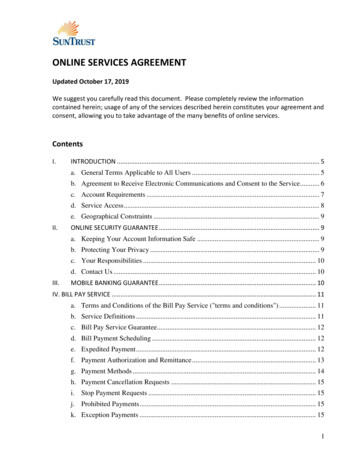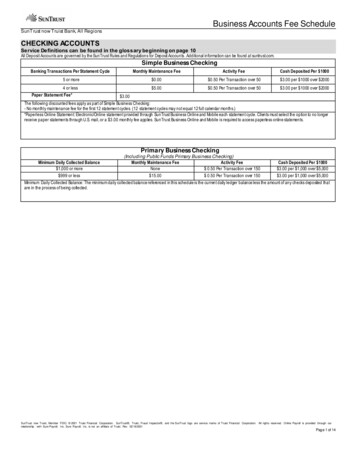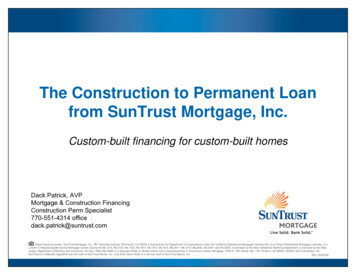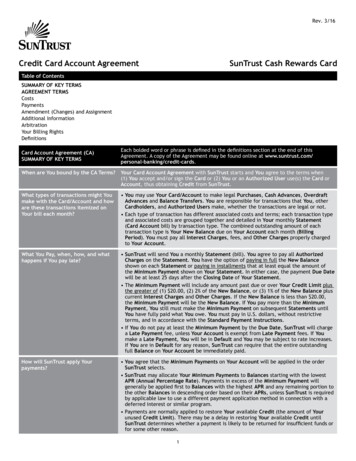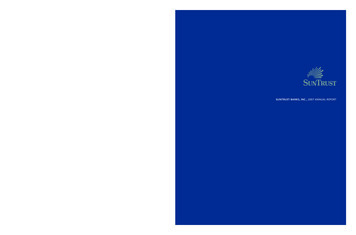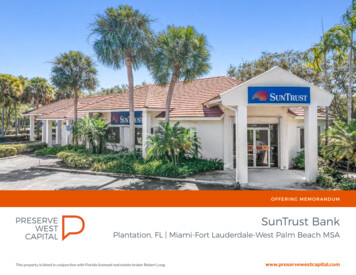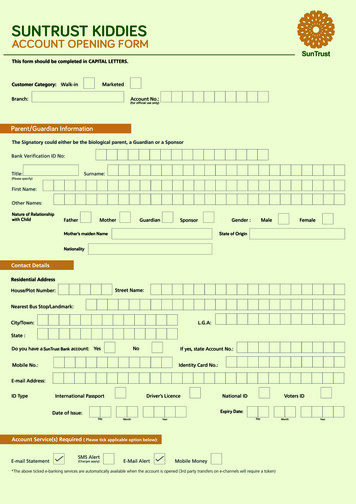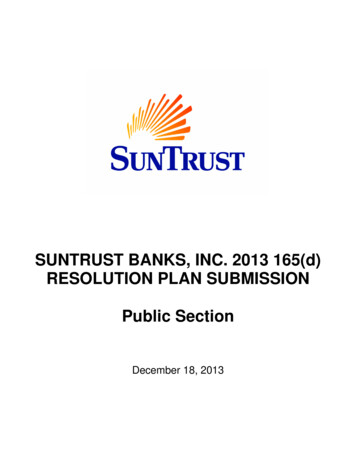
Transcription
SUNTRUST BANKS, INC. 2013 165(d)RESOLUTION PLAN SUBMISSIONPublic SectionDecember 18, 2013
Table of ContentsPublic SectionIntroduction .1A.The Names of the Material Entities .1B.Description of Core Business Lines .3C.Consolidated Financial Information Regarding Assets, Liabilities, Capital, and Major Funding Sources .4D.Description of Derivative Activities and Hedging Activities.7E.Membership in Material Payment, Clearing, and Settlement Systems.9F.Description of Foreign Operations . 10G.Identities of Material Supervisory Authorities . 11H.Identities of Principal Officers. 11I.Description of the Corporate Governance Structure and Processes Related to Resolution Planning. 12J.Description of Material Management Information Systems . 12K.High-level Description of Resolution Strategy . 13
SunTrust 2013 165(d) Resolution PlanPublic SectionPUBLIC SECTIONIntroductionSection 165(d) of the Wall Street Reform and Consumer Protection Act (the “Dodd-Frank Act”) requires bankholding companies with 50 billion or more in total assets to periodically submit to the Board of Governors of theFederal Reserve System (“Federal Reserve Board”) and Federal Deposit Insurance Corporation ("FDIC") a plan fortheir rapid and orderly resolution in the event of material distress or failure. The Federal Reserve Board and FDICsubsequently jointly adopted a final rule implementing this provision of the Dodd-Frank Act (Federal Reserve1Regulation QQ, Part 381 of the FDIC regulations, the “DFA Rule”). Separately, the FDIC's final rule coversinsured depository institutions (“IDIs”) with 50 billion or more in total assets, requiring these covered institutions tosubmit periodically to the FDIC a plan for their resolution (Part 360 of the FDIC regulations, the “Covered Insured2Depository Institution ("CIDI") Rule”).As a bank holding company ("BHC") with 50 billion or more in total assets, SunTrust Banks, Inc. (“STI”) is subjectto the DFA Rule. Similarly, SunTrust Bank (“STB”), STI’s wholly-owned IDI, is subject to the CIDI Rule because itstotal assets exceed 50 billion.As permitted under the DFA Rule, STI notified the Federal Reserve Board and FDIC in March 2013 of its intent tofile a tailored resolution plan due to its limited holdings of non-bank assets and the size of STB relative to STI.3SunTrust is a diversified financial services holding company whose businesses provide a broad range of financialservices to consumer, business, and corporate clients. Through STB, SunTrust offers a full line of financial servicesfor consumers and businesses including deposit, credit, and trust and investment services. Additional subsidiariesprovide mortgage banking, asset management, securities brokerage, capital markets, and investment bankingservices. Within its retail, commercial, and private wealth businesses, SunTrust operates primarily within Florida,Georgia, and Virginia, and enjoys strong market positions in these markets. Other markets include Maryland, NorthCarolina, South Carolina, Tennessee, West Virginia, and the District of Columbia (collectively, the "SunTrustFootprint)." Within the SunTrust Footprint, SunTrust provides its clients with a wide selection of branch-based andautomated telebanking channels, including the internet, ATMs, and twenty-four hour telebanking. Within itscorporate and investment banking, commercial real estate, and mortgage businesses, SunTrust's presence is morenational. SunTrust's client base encompasses a broad range of individuals, businesses, institutions, andgovernmental agencies. SunTrust has three primary Business Segments: Consumer Banking and Private Wealth Management Wholesale Banking Mortgage BankingAs required under the DFA Rule, CIDI Rule and related supervisory guidance, the Resolution Plan provides for theresolution of STI and STB following an idiosyncratic shock that results in the imminent failure of STI and STB. Thisidiosyncratic shock occurs at a time when general macroeconomic conditions are consistent with certain baselineassumptions in which the United States financial system is not experiencing a system-wide financial panic or othercrisis. The Resolution Plan demonstrates how the material entities and core business lines of SunTrust could beresolved in a reasonable period of time, without the use of any extraordinary government support, without fundsfrom the United States taxpayer and without the use of Title II Orderly Liquidation Authority, and in a manner thatsubstantially mitigates the risk that the failure of these material entities or core business lines would have a seriousadverse effect on financial stability in the United States.123Federal Reserve Board and FDIC, Resolution Plans Required, 76 Fed. Reg. 67323 (Nov. 1, 2011).FDIC, Resolution Plans Required for Insured Depository Institutions with 50 billion or more in Total Assets, 77 Fed. Reg.3075 (Jan. 23, 2012).The term “SunTrust” refers to the consolidated enterprise.1
SunTrust 2013 165(d) Resolution PlanPublic SectionIn addition, the SunTrust resolution strategies: Enable STB to be resolved at the least cost to the Deposit Insurance Fund. Ensure that depositors have access to their insured deposits within one business day of the failure of STB. Maximize the net present value return from the sale or disposition of the STB's assets and minimize theamount of any loss realized by the creditors in the resolution of STB. Ensure the continuation of critical services of STB despite the failure of STB. Maintain public confidence in the United States banking system and is least disruptive to depositors andother stakeholders. Facilitate separability from the rest of SunTrust. Otherwise maximize return to claimants.This Public Section summarizes the key elements of the Resolution Plan.Unless otherwise indicated, information in this Public Section is provided as of December 31, 2012.A. The Names of Material Entities4Under the DFA Rule, a material entity is any subsidiary that is significant to the activities of a critical operation orcore business line of a covered company. Under the CIDI Rule, a material entity is any company that is significant5to the activities of a critical service or core business line. SunTrust identified the following material entities: STI is the top-tier legal entity in SunTrust’s organizational structure. It is a bank holding company that haselected financial holding company status under the Bank Holding Company Act. Its shares are publiclytraded on the New York Stock Exchange. It is a material entity under the CIDI Rule and the coveredcompany under the DFA Rule. STB is a wholly-owned, indirect subsidiary of STI and is a Georgia state-chartered member bank. STB andits subsidiaries hold approximately 97% of SunTrust’s total assets and employ over 92% of total SunTrustemployees. The material elements of three of SunTrust's four core business lines are contained within STB.Similarly, all internally-provided critical services, with one exception, are contained within STB. It is amaterial entity under the DFA Rule and the covered IDI under the CIDI Rule. SunTrust Mortgage, Inc. (“STM”) is a wholly-owned subsidiary of STB that originates, purchases, sells, andservices mortgage whole loans. It contains SunTrust’s only core business line and internally-providedcritical services that are not housed in STB. It is a material entity under both the DFA and CIDI Rules.4Critical operations are those operations, including associated services, functions, and support, the failure or discontinuance ofwhich, in the view of the covered company or as jointly directed by the Federal Reserve Board and the FDIC, would pose athreat to the financial stability of the United States. SunTrust has no critical operations.5Critical services are those services and operations of the IDI, such as servicing information technology support and operations,human resources and personnel, that are necessary to continue the day-to-day operations of the IDI.2
SunTrust 2013 165(d) Resolution PlanPublic SectionB. Description of Core Business LinesUnder the DFA and CIDI Rules, core business lines are defined as those business lines, including associatedoperations, services, functions, and support, that upon failure would result in a material loss of revenue, profit, orfranchise value. Because of STB’s dominant role in the overall SunTrust organization, the core business lines ofSTI and STB are the same. SunTrust identified the following four core business lines: Retail Banking provides banking solutions to retail clients exclusively within the SunTrust footprint, andserves the Private Wealth Management core business line and wholesale banking segment clients throughits network of branches. Commercial and Business Banking offers a comprehensive line of banking (for example, deposits, treasuryand cash management, lending, leasing, etc.), capital markets, and investment management solutions tobusinesses, institutions, not-for-profit organizations, and government entities. Private Wealth Management provides a range of services to high net worth and ultra-high net worthindividuals and institutions, including brokerage, trust, estate, financial planning, private banking, familyoffice, and lending through multiple channels both within and outside the SunTrust Footprint. Mortgage Banking offers residential mortgage products nationally through its retail, consumer direct, broker,and correspondent channels.3
SunTrust 2013 165(d) Resolution PlanPublic SectionC. Consolidated Financial Information Regarding Assets, Liabilities, Capital,and Major FundingInformation on the consolidated balance sheet and regulatory capital of STI and STB are presented below.Table C.1 – Consolidated Balance Sheets4
SunTrust 2013 165(d) Resolution PlanPublic SectionThe following table depicts Basel I calculations of regulatory capital ratios for SunTrust and STB, consolidated withits subsidiaries, as of December 31, 2012.Table C.2 – Regulatory Capital Summary5
SunTrust 2013 165(d) Resolution PlanPublic SectionThe following table depicts Basel I calculations of SunTrust's Tier 1 common equity, risk-weighted assets, and Tier1 common equity ratio as of December 31, 2012.Table C.3 - SunTrust Regulatory Capital - Basel IThe following table depicts the proposed Basel III calculations of SunTrust's Tier 1 common equity, risk-weightedassets, and Tier 1 common equity ratio as of December 31, 2012. These calculations are based on SunTrust'sinterpretation of the notice of proposed rulemaking issued by the Federal Reserve in June 2012.Table C.4 - SunTrust Regulatory Capital - Proposed Basel IIIFor additional financial information on SunTrust, please refer to annual, quarterly and current reports filed with theSEC and available at www.sec.gov.STB is the most significant source of funding for SunTrust. STB is funded primarily by deposits, with secondarysources of funding from Federal Home Loan Bank advances, and senior and subordinated debt issuances.6
SunTrust 2013 165(d) Resolution PlanPublic SectionTable C.5 – Funding SourcesD. Description of Derivative Activities and Hedging ActivitiesSunTrust enters into various derivative financial instruments, both in a dealer capacity to facilitate client transactionsand for risk management purposes. SunTrust generally manages the risk associated with these derivatives withinthe framework of its value-at-risk ("VaR") approach that monitors the risk associated with covered positions'exposure. Derivatives are used as a risk management tool to hedge SunTrust’s balance sheet exposure to changesin identified cash flow and fair value risks, either economically or in accordance with hedge accounting provisions.SunTrust’s Corporate Treasury function is responsible for employing the various hedging strategies to managethese objectives. Additionally, as a normal part of its operations, SunTrust enters into interest rate lockcommitments on mortgage loans that are accounted for as freestanding derivatives and has certain contractscontaining embedded derivatives that are carried, in their entirety, at fair value.7
SunTrust 2013 165(d) Resolution PlanPublic SectionThe following tables present SunTrust’s derivative positions as of December 31, 2012, and 2011.Table D.1 – Derivatives Assets and Liabilities8
SunTrust 2013 165(d) Resolution PlanPublic SectionE. Memberships in Material Payment, Clearing, and Settlement SystemsThe following table identifies the memberships of SunTrust legal entities in material payment, clearing, andsettlement systems.Table E.1 – Memberships in Material Payment, Clearing, and Settlement SystemsAs of December 31, 2012SystemPayment Utilities Direct ParticipationFedwireSwiftFedACHElectronic Payments Network (The Clearing House)Viewpointe (check imaging)Payment Systems Indirect Access through Counterparty AgentsLegal Entity with MembershipSTBSTBSTBSTBSTICorrespondent banks for USD clearing: HSBC Bank, New York branch Citibank, NA Standard Chartered Bank, New York branch JPMorgan Chase Bank, NASTBCorrespondent banks for FX Clearing: Royal Bank of Scotland Canadian Bank of Commerce HSBC Bank - Shanghai, Hong Kong, London Bank of Tokyo Bank of Nova Scotia - Mumbai Australia and New Zealand Banking Group Limited - Australia, NewZealand UBS Ceskoslovenska Obshadni Bank Raiffeisen Bank Citibank, NA - Mexico, Saudia Arabia, Kuwait, Israel Bank Polska Kasa Opieki Skandinaviska Enskilda Baken - Sweden, Denmark, Norway DBS Bank Ltd ABSA Bank Deutsche Bank Standard Chartered Bank - UAESTBFederal Reserve Board Check via ViewpointeClearinghouses Direct ParticipationDepository Trust & Clearing Corporation ("DTCC") (2095)STIDTCC (2114)National Securities Clearing Corporation ("NSSC")Clearinghouses Indirect Access through Counterparty AgentsNSCC via National Financial ServicesSunTrust Robinson Humphrey, Inc. (“STRH”),a subsidiary of STISTBSTRHSTBSTBCME (12402S) via: JPMorgan Chase Bank, NA Barclays Bank Citibank, NA Wells Fargo Bank, NA9
SunTrust 2013 165(d) Resolution PlanPublic SectionSystemLegal Entity with MembershipSTBLCH.Clearnet Group ("LCH")(STBSNTBKXXX) via: JPMorgan Chase Bank, NA Barclays Bank Citibank, NA Wells Fargo Bank, NASTBIntercontinentalExchange("ICE") via: Ice Links Markit (DTCC)Settlement Utilities Direct ParticipationNSCCSettlement Systems Indirect Access through Counterparty AgentsThe Bank of New York Mellon ("BoNY") for Fixed IncomeBoNY for Fixed IncomeMoney Transfer System (Fedwire)ISA (SWIFT)SunTrust Treasury Management (Automated Clearing House ("ACH")) for FXSecurities Depositories Direct AccessDepository Trust Company ("DTC")NSCCFedlineSecurities Depositories Indirect Access through Counterparty AgentsFixed Income Clearing Corporation ("FICC") via BroadridgeGovernment Agencies Direct AccessFederal Housing AdministrationFreddie MacFannie MaeGinnie MaeOther Systems Direct ParticipationMastercard (debit and credit)Visa (gift and prepaid)STAR (ATM)Cirrus (ATM)PLUS (ATM)New York Currency Exchange (ATM)Interlink (POS)Source: Interviews with LOB and Functional SMEs, consolidated into P1T5 data collection TMSTMSTMSTBSTBSTBSTBSTBSTBSTB
SunTrust 2013 165(d) Resolution PlanPublic SectionF. Description of Foreign OperationsSunTrust does not have material foreign operations.G. Identities of Material Supervisory AuthoritiesAs a bank holding company, STI is supervised on a fully consolidated basis by the Federal Reserve Board. TheFederal Reserve Bank of Atlanta supports the Federal Reserve Board in the fulfillment of its supervision andregulation of STI under delegated authority. STB is a member of the Federal Reserve System and is regulated bythe Federal Reserve Board, Federal Reserve Bank of Atlanta, the FDIC, and the Georgia Department of Bankingand Finance. Some of STI’s non-bank subsidiaries are regulated and supervised by various other regulatorybodies, including, but not limited to, the Securities and Exchange Commission ("SEC"), Commodity Futures TradingCommission ("CFTC"), Financial Industry Regulatory Authority ("FINRA"), National Futures Association ("NFA"),and state insurance authorities.H. Identities of Principal OfficersThe principal officers of STI and STB are the same and are identified below. The officers are the same for both STIand STB.Table H-1: Principal Officers in Alphabetical OrderAs of December 31, 2012Principal OfficerTitleKenneth J. CarrigCorporate Executive Vice President and Chief Human Resources OfficerMark A. ChancyCorporate Executive Vice President and Wholesale Banking ExecutiveAnil T. CheriyanCorporate Executive Vice President and Chief Information OfficerHugh S. (Beau) Cummins, IIICorporate Executive Vice President, Corporate and Investment Banking ExecutiveRilla S. DelorierCorporate Executive Vice President, Chief Marketing and Client Experience OfficerBrad R. DinsmoreCorporate Executive Vice President, Consumer Banking and Private Wealth ManagementExecutiveRaymond D. FortinCorporate Executive Vice President, General Counsel and Corporate SecretaryThomas E. FreemanCorporate Executive Vice President and Chief Risk OfficerAleem GillaniCorporate Executive Vice President and Chief Financial OfficerThomas G. KuntzCorporate Executive Vice President, Commercial and Business Banking and GeographicLeadership ExecutiveJerome T. Lienhard, IICorporate Executive Vice President and Mortgage Banking ExecutivePresident and Chief Executive Officer of SunTrust Mortgage, Inc.William H. Rogers, Jr.Chairman and Chief Executive Officer11
SunTrust 2013 165(d) Resolution PlanPublic SectionI. Description of the Corporate Governance Structure and ProcessesRelated to ResolutionSunTrust has implemented a governance framework for development, review, and approval of itsResolution Plan and for ongoing monitoring of resolution planning matters. As required under the DFAand CIDI Rules, the Resolution Plan was approved by the STI and STB Boards of Directors pursuant to aprocess that involved active, informed participation across SunTrust’s business units and corporatefunctions.Full time SunTrust resources have been and continue to be devoted to resolution planning activities.SunTrust has established an Enterprise Recovery and Resolution Planning Department (“ERRP”) tocoordinate development, review, and approvals related to the Resolution Plan and to conduct ongoingmonitoring and maintenance related thereto. ERRP operates as a unit within SunTrust’s CorporateOperational Risk Management ("CORM") Department, and is the central point of control with respect tothe resolution planning governance structure. ERRP worked with a Work Stream Owners Team,composed of management from key corporate functions, to gather and synthesize information forinclusion in the Resolution Plan. ERRP and Work Stream Owners conducted regular meetings during thecritical formative and approval stages of the Resolution Plan.Further, ERRP and the Work Stream Owners met with and reported to an Executive Strategy Team(“EST”) frequently during the course of the development of the Resolution Plan to provide oversight, setdirection, conduct review and determine executive approvals. The EST leadership team is composed ofselect principal officers. In addition, the Corporate Risk Committee monitored resolution planningprogress throughout the year. The engagement of select principal officers and the Corporate RiskCommittee is designed to promote transparency and communication of resolution planning considerationsacross SunTrust governance.SunTrust’s Board Risk Committee ("BRC") provided oversight of Resolution Plan development throughquarterly updates during which key aspects of the Resolution Plan were discussed. The full Boards ofDirectors of both STI and STB confirmed and approved the final Resolution Plan.In addition to the oversight and approval processes noted above, the resolution planning process wassubject to several layers of internal controls to ensure the accuracy and relevance of information includedin the Resolution Plan. Resolution Plan sections were reviewed in detail by relevant business andcorporate function management. Further, SunTrust Audit Services participated as an observer inERRP/Work Stream Owners Team meetings as well as EST meetings, and conducted independent auditreviews during the course of Resolution Plan development.J. Description of Material Management Information SystemsSunTrust's Enterprise Information Services (“EIS”) provides technology and operations services insupport of SunTrust’s clients and employees. The EIS team is responsible for developing and operatingtechnology services, and managing technology outsourcing to third-party vendors. EIS reports toSunTrust's Chief Information Officer. EIS, in conjunction with the business lines, supports managementinformation systems ("MIS"), which are utilized to support business activities, branch banking, lendingoperations, accounting, finance, risk and compliance management. SunTrust's two primary depositapplication systems house savings and checking accounts, as well as CDs and IRAs. SunTrust alsoutilizes MIS to produce management and regulatory reports, as well as some information underlying theResolution Plan.EIS employs a matrix operating model in which major technology services are paired with the businessunits they support to deliver and support critical applications and systems. The primary Information12
SunTrust 2013 165(d) Resolution PlanPublic SectionTechnology data center ("DC") for SunTrust supports back-end operations, hosts the majority of in-houseand vendor-licensed applications, and serves as a gateway to vendor-hosted applications. SunTrustmaintains a separate backup data center for disaster recovery.SunTrust has a Business Continuity / Disaster Recovery (“BC/DR”) program that enables SunTrust toresume normal business operations, minimize financial losses, continue financial and risk reporting withinestablished parameters, and serve our customers in the event of disaster. The criticality of eachapplication or system supporting a critical business process determines its applicable recovery window.K. High-level Description of Resolution StrategyIn the event of failure, STB would be subject to FDIC receivership under the Federal Deposit InsuranceAct. SunTrust considered a number of sale and disposition options to ensure maximum value for thereceivership, least cost to the Deposit Insurance Fund, and access to insured deposits within onebusiness day, as required by the CIDI Rule. These options included, but were not limited to, the sale ofSTB in its entirety to a third-party purchaser pursuant to a purchase and assumption agreement, as wellas separate sale of specific groups of branches by geography, sale of core business lines, and sale ofmaterial entities or the transfer of insured deposits only.Given STI's dependency on STB, STI will file a voluntary Chapter 11 bankruptcy petition as soon aspracticable following a scenario of STB’s failure, and STI would likely proceed with a liquidation of itsremaining individual assets.These strategies are designed to ensure the rapid and orderly resolution of SunTrust pursuant to aneffective and feasible plan.13
Footprint)." Within the SunTrust Footprint, SunTrust provides its clients with a wide selection of branch-based and automated telebanking channels, including the internet, ATMs, and twenty-four hour telebanking. Within its corporate and investment banking, commercial real estate, and mortgage businesses, SunTrust's presence is more national.
